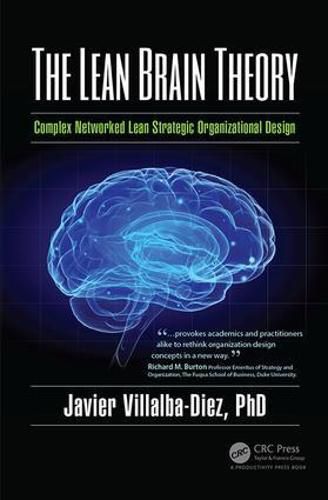Readings Newsletter
Become a Readings Member to make your shopping experience even easier.
Sign in or sign up for free!
You’re not far away from qualifying for FREE standard shipping within Australia
You’ve qualified for FREE standard shipping within Australia
The cart is loading…






The most complex organization known in the universe is inside of our heads: our brain. Because organizations are formed by human beings, The Lean Brain Theory aims to mimic human brain structure and functionality so as to enable the emergence of brain-like organizations in which the ‘neurons’ are the human-beings and the ‘axons’ ought to be Lean Management oriented behavioral and communication patterns. These networks ought to evolve towards brain-like configurations that display thinking-like processes and ultimately organizational consciousness. The Lean Brain Theory offers a quantifiable holistic framework to strategically design any organization as a human brain. By embedding complexity into the Strategic Organizational Design (SOD) and combining this with Lean Management and neuropsychological state of the art knowledge, The Lean Brain Theory ends up with the Brain-Organization metaphor and makes it possible.
This idea of embedding complexity into organizational design is a follow up to the book The Hoshin Kanri Forest. That book dealt with the methodology of creating ‘forest-like’ topologies. The Lean Brain Theory aims to set the ground for Lean organizations of the future that embrace both Business Intelligence and Complex Networked Lean Strategic Organizational Design. The organization as a super-network evolves towards ‘intelligent’ Human-Brain-like entity. The Lean Brain Theory ultimately seeks to integrate an anthropomorphic organizational paradigm with future tendencies of technological advances. In this way, the brain-like organization emerging from it can be regarded as bionic.
$9.00 standard shipping within Australia
FREE standard shipping within Australia for orders over $100.00
Express & International shipping calculated at checkout
The most complex organization known in the universe is inside of our heads: our brain. Because organizations are formed by human beings, The Lean Brain Theory aims to mimic human brain structure and functionality so as to enable the emergence of brain-like organizations in which the ‘neurons’ are the human-beings and the ‘axons’ ought to be Lean Management oriented behavioral and communication patterns. These networks ought to evolve towards brain-like configurations that display thinking-like processes and ultimately organizational consciousness. The Lean Brain Theory offers a quantifiable holistic framework to strategically design any organization as a human brain. By embedding complexity into the Strategic Organizational Design (SOD) and combining this with Lean Management and neuropsychological state of the art knowledge, The Lean Brain Theory ends up with the Brain-Organization metaphor and makes it possible.
This idea of embedding complexity into organizational design is a follow up to the book The Hoshin Kanri Forest. That book dealt with the methodology of creating ‘forest-like’ topologies. The Lean Brain Theory aims to set the ground for Lean organizations of the future that embrace both Business Intelligence and Complex Networked Lean Strategic Organizational Design. The organization as a super-network evolves towards ‘intelligent’ Human-Brain-like entity. The Lean Brain Theory ultimately seeks to integrate an anthropomorphic organizational paradigm with future tendencies of technological advances. In this way, the brain-like organization emerging from it can be regarded as bionic.